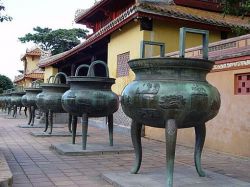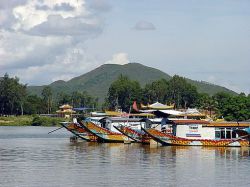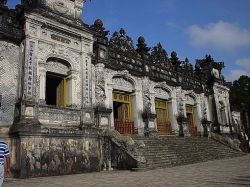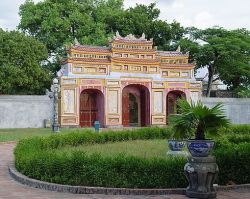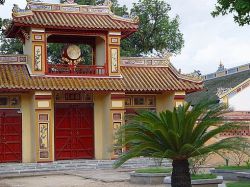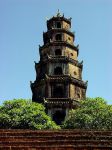Common description
Located in the heart of Vietnam, the province of Thia Thien - Gue extends from the impressive mountains of Chyong Shon in the West to the warm shores of the South China Sea. The unique landscape of these lands and the rich historical past of the province make Thia Thien - Gue a fascinating place for tourism.
The ancient land of Gué entered the annals of Dai Viet culture as early as the 13th century, thanks to a wedding ceremony combining the descendants of the ruling Tiampa dynasty and the rulers of the Chan dynasty. More than 400 years later, this region was the political and cultural center of the feudal state of Vietnam, which could not but leave a rich cultural and architectural imprint in every corner of this amazing land. Hundreds of historical and cultural sights have been preserved, and the most magnificent of them are the palaces and mausoleums of the rulers of Nguyen and emperors. Thia Thien-Gue has a heroic revolutionary history: many relics associated with the life and revolutionary activities of Ho Chi Minh and other famous historical personalities stored in the museums of the province. It is striking in its grandeur that the complex of cultural monuments recognized by UNESCO as a monument of world cultural heritage, including 300 architectural objects (citadels, palaces, temples and mausoleums). The culture of Gué also includes millennia of craftsmanship in the villages: jewelry, bronze casting and embroidery.
Worth to visit:
Royal fortress. Located on the banks of the Huong River (Fragrant), this fortress is famous for its impregnability - the six-meter-high walls surrounded by a moat reliably protected the citadel from external enemies.
The imperial palace complex. Located in the center of the fortress, the imperial complex consists of the Midday Gate, the inner ceremonial courtyard, the Thai Tha Hoa Palace, the Dai Kung Gate (Grand Courtyard), the Thyong Uen (Royal) Garden, the Chieu Temple, the Thai Temple, the Hien Lam Pavilion, the Hung and Fung Tien Temples .
Forbidden Purple City. Built during the reign of Emperor Zha Long and originally named Kung Thanh - the city of Residences, this architectural ensemble is made truly with an imperial scale.
Royal tombs. Eight royal tombs - the last refuge of the Nguyen kings stretch the pediment to the southwest, in the direction of the Imperial city. The construction of these structures began, as a rule, even during the life of the ruler, therefore the decoration and architecture of these buildings are so different from each other: the views, tastes and architectural preferences of the kings now resting in them had a great influence on the appearance of the tombs.
Pagoda Thien Mu. The oldest pagoda dating back to 1601 in Gué was built by the governor of the city Nguyen Hoang after a vision happened to him - the old woman told him about the supernatural powers of this place, on which the sanctuary should be built. Heavily damaged in the war, in 1943, the building was under reconstruction for more than thirty years, thanks to which it restored its original appearance. The complex includes two zones: the front one with towers and the back one with tombs.
Pagoda You Dam. It was founded by the Chinese monk Minh Hoang Thou Dung at the end of the 17th century under the rule of Emperor Le Hee Tong. One of the attractions of the pagoda is a tree grafted from a sacred tree brought to Vietnam by Buddhists from India in 1936. In 1951, a congress of the Buddhist Association was held in the pagoda. Now here is the headquarters of the council of the Buddhist Association of the province of Thia Thien.
Museum of Antiquity Gue. The refined building, originally named Long An Palace, was dismantled and re-built in 1909 at its current location to become a library and institution. This building is a monument of special value because it contains wooden panels on which the poetry and essays composed by him by Emperor Thieu Chi are inscribed. The Gué Museum of Antiquity is a gallery of collections of bronze, ceramics, porcelain, furniture, royal robes and personal belongings of former Vietnamese emperors. Ho Chi Minh Museum. Here are some exhibits and photographs related to the life and revolutionary activities of President Ho Chi Minh, especially concerning his ten-year stay in Gué.
Zyong No village. The village was founded by the Vietnamese for a long time. At the very beginning of its history, Zyong No was a prosperous settlement, where the roots of literary and military traditions were born. A temple of grandiose and stunning construction was built here with its magnificent majestic architecture - a typical example of Vietnamese village architecture. The village is also known as the place where former President Ho Chi Minh spent his childhood. The house in which Ho and his father lived was facing the facade to the southeast. After the reunification of the country in 1975, local authorities restored its original architecture so that it could serve as a memory of “Uncle Ho”. Today, the house is full of various exhibits and photographs.
Cathedral Fu Kam. A striking example of combining modern architecture and following the traditions of the past, this cathedral was built in 1965 according to the modern architectural project of the architect Ngo Viet Thu. During construction, new concepts were used, such as, for example, the use of support columns adjoining walls. Three pillars in each corner create the effect of a large space for the altar. The interior of the cathedral is built according to classical traditions: two rows of stained glass windows are located on the upper gallery, and the holy cross of steel and concrete is located in the central aisle.
The fragrant river. The fragrant (fragrant) river, in Vietnamese, Huong Zhang, has a length of 30 km and a very slow flow of water, since it is located almost at sea level. The river flows through picturesque villages and big cities, the view on both sides of the river is magnificent. Citadels, gardens, pagodas, towers and temples reflected in the leisurely waters of the river give the landscape even more poetry and make you forget about time.
Mount Ngu Binh. It is no accident that Emperor Zhang Long built the capital of Gué next to Ngu Binh - this impressive mountain community served as an additional shield to the city.
Bat Ma National Park. Bat Ma National Park is located approximately 50 km north of Gue. In the 1930s, the city was located in the mountains, but was almost completely destroyed after the revolution of 1946 - 1954. All that remains is the ruins of Roman-style city buildings hidden by dense vegetation .. The park has a lot to offer its guests: sightseeing lovers, connoisseurs of beautiful landscapes, and naturalists will love the park's rich flora and fauna . It is home to 233 species of birds and 55 species of mammals, as well as an extensive flora numbering more than 500 species of plants. Here, deep scientific research is constantly conducted.
The ancient land of Gué entered the annals of Dai Viet culture as early as the 13th century, thanks to a wedding ceremony combining the descendants of the ruling Tiampa dynasty and the rulers of the Chan dynasty. More than 400 years later, this region was the political and cultural center of the feudal state of Vietnam, which could not but leave a rich cultural and architectural imprint in every corner of this amazing land. Hundreds of historical and cultural sights have been preserved, and the most magnificent of them are the palaces and mausoleums of the rulers of Nguyen and emperors. Thia Thien-Gue has a heroic revolutionary history: many relics associated with the life and revolutionary activities of Ho Chi Minh and other famous historical personalities stored in the museums of the province. It is striking in its grandeur that the complex of cultural monuments recognized by UNESCO as a monument of world cultural heritage, including 300 architectural objects (citadels, palaces, temples and mausoleums). The culture of Gué also includes millennia of craftsmanship in the villages: jewelry, bronze casting and embroidery.
Worth to visit:
Royal fortress. Located on the banks of the Huong River (Fragrant), this fortress is famous for its impregnability - the six-meter-high walls surrounded by a moat reliably protected the citadel from external enemies.
The imperial palace complex. Located in the center of the fortress, the imperial complex consists of the Midday Gate, the inner ceremonial courtyard, the Thai Tha Hoa Palace, the Dai Kung Gate (Grand Courtyard), the Thyong Uen (Royal) Garden, the Chieu Temple, the Thai Temple, the Hien Lam Pavilion, the Hung and Fung Tien Temples .
Forbidden Purple City. Built during the reign of Emperor Zha Long and originally named Kung Thanh - the city of Residences, this architectural ensemble is made truly with an imperial scale.
Royal tombs. Eight royal tombs - the last refuge of the Nguyen kings stretch the pediment to the southwest, in the direction of the Imperial city. The construction of these structures began, as a rule, even during the life of the ruler, therefore the decoration and architecture of these buildings are so different from each other: the views, tastes and architectural preferences of the kings now resting in them had a great influence on the appearance of the tombs.
Pagoda Thien Mu. The oldest pagoda dating back to 1601 in Gué was built by the governor of the city Nguyen Hoang after a vision happened to him - the old woman told him about the supernatural powers of this place, on which the sanctuary should be built. Heavily damaged in the war, in 1943, the building was under reconstruction for more than thirty years, thanks to which it restored its original appearance. The complex includes two zones: the front one with towers and the back one with tombs.
Pagoda You Dam. It was founded by the Chinese monk Minh Hoang Thou Dung at the end of the 17th century under the rule of Emperor Le Hee Tong. One of the attractions of the pagoda is a tree grafted from a sacred tree brought to Vietnam by Buddhists from India in 1936. In 1951, a congress of the Buddhist Association was held in the pagoda. Now here is the headquarters of the council of the Buddhist Association of the province of Thia Thien.
Museum of Antiquity Gue. The refined building, originally named Long An Palace, was dismantled and re-built in 1909 at its current location to become a library and institution. This building is a monument of special value because it contains wooden panels on which the poetry and essays composed by him by Emperor Thieu Chi are inscribed. The Gué Museum of Antiquity is a gallery of collections of bronze, ceramics, porcelain, furniture, royal robes and personal belongings of former Vietnamese emperors. Ho Chi Minh Museum. Here are some exhibits and photographs related to the life and revolutionary activities of President Ho Chi Minh, especially concerning his ten-year stay in Gué.
Zyong No village. The village was founded by the Vietnamese for a long time. At the very beginning of its history, Zyong No was a prosperous settlement, where the roots of literary and military traditions were born. A temple of grandiose and stunning construction was built here with its magnificent majestic architecture - a typical example of Vietnamese village architecture. The village is also known as the place where former President Ho Chi Minh spent his childhood. The house in which Ho and his father lived was facing the facade to the southeast. After the reunification of the country in 1975, local authorities restored its original architecture so that it could serve as a memory of “Uncle Ho”. Today, the house is full of various exhibits and photographs.
Cathedral Fu Kam. A striking example of combining modern architecture and following the traditions of the past, this cathedral was built in 1965 according to the modern architectural project of the architect Ngo Viet Thu. During construction, new concepts were used, such as, for example, the use of support columns adjoining walls. Three pillars in each corner create the effect of a large space for the altar. The interior of the cathedral is built according to classical traditions: two rows of stained glass windows are located on the upper gallery, and the holy cross of steel and concrete is located in the central aisle.
The fragrant river. The fragrant (fragrant) river, in Vietnamese, Huong Zhang, has a length of 30 km and a very slow flow of water, since it is located almost at sea level. The river flows through picturesque villages and big cities, the view on both sides of the river is magnificent. Citadels, gardens, pagodas, towers and temples reflected in the leisurely waters of the river give the landscape even more poetry and make you forget about time.
Mount Ngu Binh. It is no accident that Emperor Zhang Long built the capital of Gué next to Ngu Binh - this impressive mountain community served as an additional shield to the city.
Bat Ma National Park. Bat Ma National Park is located approximately 50 km north of Gue. In the 1930s, the city was located in the mountains, but was almost completely destroyed after the revolution of 1946 - 1954. All that remains is the ruins of Roman-style city buildings hidden by dense vegetation .. The park has a lot to offer its guests: sightseeing lovers, connoisseurs of beautiful landscapes, and naturalists will love the park's rich flora and fauna . It is home to 233 species of birds and 55 species of mammals, as well as an extensive flora numbering more than 500 species of plants. Here, deep scientific research is constantly conducted.
Hue on map
+ 20°C

